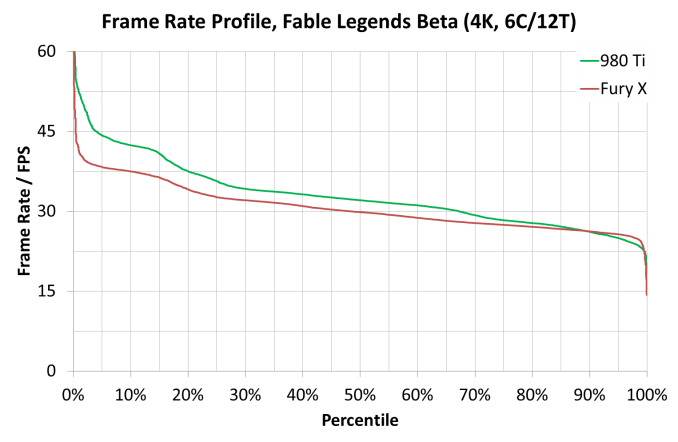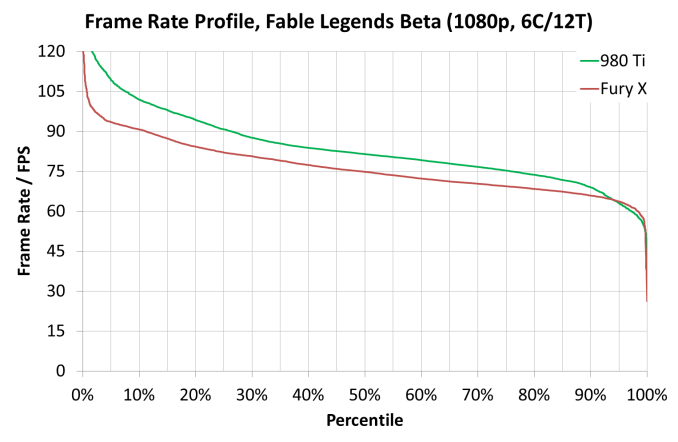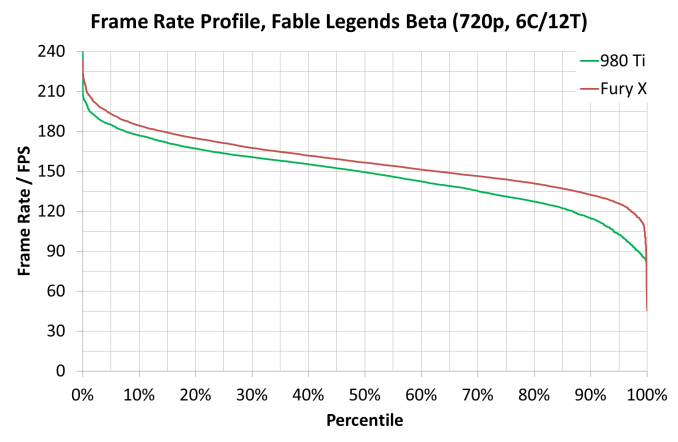Fable Legends Early Preview: DirectX 12 Benchmark Analysis
by Ryan Smith, Ian Cutress & Daniel Williams on September 24, 2015 9:00 AM ESTComparing Percentile Numbers Between the GTX 980 Ti and Fury X
As the two top end cards from both graphics silicon manufacturers were released this year, there was all a big buzz about which is best for what. Ryan’s extensive review of the Fury X put the two cards head to head on a variety of contests. For DirectX 12, the situation is a little less clear cut for a number of reasons – games are yet to mature, drivers are also still in the development stage, and both sides competing here are having to rethink their strategies when it comes to game engine integration and the benefits that might provide. Up until this point DX12 contests have either been synthetic or having some controversial issues. So for Fable Legends, we did some extra percentile based analysis for NVIDIA vs. AMD at the top end.
For this set of benchmarks we ran our 1080p Ultra test with any adaptive frame rate technology enabled and recorded the result:
For these tests, usual rules apply – GTX 980 and Fury X, in our Core i7/i5/i3 configurations at all three resolution/setting combinations (3840x2160 Ultra, 1920x1080 Ultra and 1280x720 Low). Data is given in the form of frame rate profile graphs, similar to those on the last page.
As always, Fable Legends is still in early access preview mode and these results may not be indicative of the final version, but at this point they still provide an interesting comparison.
At 3840x2160, both frame rate profiles from each card looks the same no matter the processor used (one could argue that the Fury X is mildly ahead on the i3 at low frame rates), but the 980 Ti has a consistent gap across most of the profile range.
At 1920x1080, the Core i7 model gives a healthy boost to the GTX 980 Ti in high frame rate scenarios, though this seems to be accompanied by an extended drop off region in high frame rate areas. It is also interesting that in the Core i3 mode, the Fury X results jump up and match the GTX 980 Ti almost across the entire range. This again points to some of the data we saw on the previous page – at 1080p somehow having fewer cores gave the results a boost due to lighting scenarios.
At 1280x720, as we saw in the initial GPU comparison page on average frame rates, the Fury X has the upper hand here in all system configurations. Two other obvious points are noticeable here – moving from the Core i5 to the Core i7, especially on the GTX 980 Ti, makes the easy frames go quicker and the harder frames take longer, but also when we move to the Core i3, performance across the board drops like a stone, indicating a CPU limited environment. This is despite the fact that with these cards, 1280x720 at low settings is unlikely to be used anyway.













141 Comments
View All Comments
medi03 - Thursday, September 24, 2015 - link
"AMD had driver with better results, but we didn't use it", "oh, Bryan tested it, but he's away" adds some sauce to it.Oxford Guy - Thursday, September 24, 2015 - link
"we are waiting for a better time to test the Ashes of the Singularity benchmark"L-O-L
Frenetic Pony - Thursday, September 24, 2015 - link
This is as usual a trolley, click bait response. The truth is far more complex than whether one side "wins". Here we can see Amds older card once again benefiting greatly from Dx12, to the point where it clearly pulls ahead of Nvidias similarly priced options. Yet on the high end it seems Nvidia has scaled it's gpu architecture better than Amd has, with the 980ti having the advantage. So, technology, like life, is complicated and not prone to simple quips that accurately reflect reality.jospoortvliet - Friday, September 25, 2015 - link
True. One thing has not changed and becomes more pronounced with DirectX12: AMD offers better performance at every price point.Th-z - Thursday, September 24, 2015 - link
Are you referring to AotS results? That benchmark stresses different things than this classic flyby benchmark, both are useful in their own right. AotS's more akin to real gameplay and stresses draw call capability of DX12, which is *the* highlights of DX12.My question for Ryan, Anandtech didn't test AotS because you said it's still in the early developmental stage, however this one isn't? I say test them all, make interesting before-and-after study cases regardless. Also have you considered improving your comment section?
DoomGuy64 - Friday, September 25, 2015 - link
Incorrect. The $650 Ti is the only Nvidia card better in dx12, and it has 96 ROPs, compared to the Fury's 64, not that Fury is actually doing that bad. AMD on the other hand, is cleaning up with the mid-range cards, which is what most people are buying.masaville888 - Saturday, October 10, 2015 - link
I left AMD for good after too many years of technical issues such as artifacting, poorly optimized drivers and so forth. I always had a good experience with nVidia and after going back I have no regrets. AMD seems more interested in tech announcements than user experience. If they figure out the customer side of things they have the potential to be great, but not until then.lprates - Thursday, October 15, 2015 - link
I totally Agreelprates - Thursday, October 15, 2015 - link
I totally Agreelprates - Sunday, October 18, 2015 - link
I totally Agree